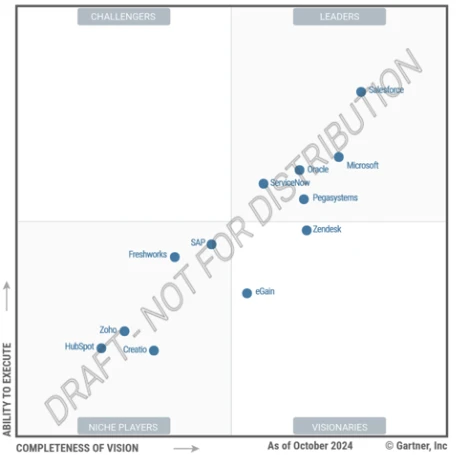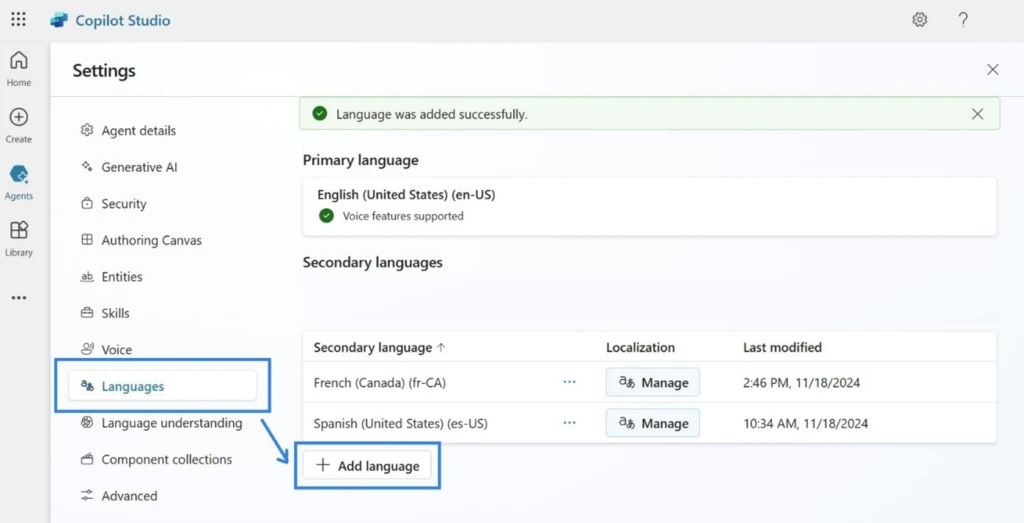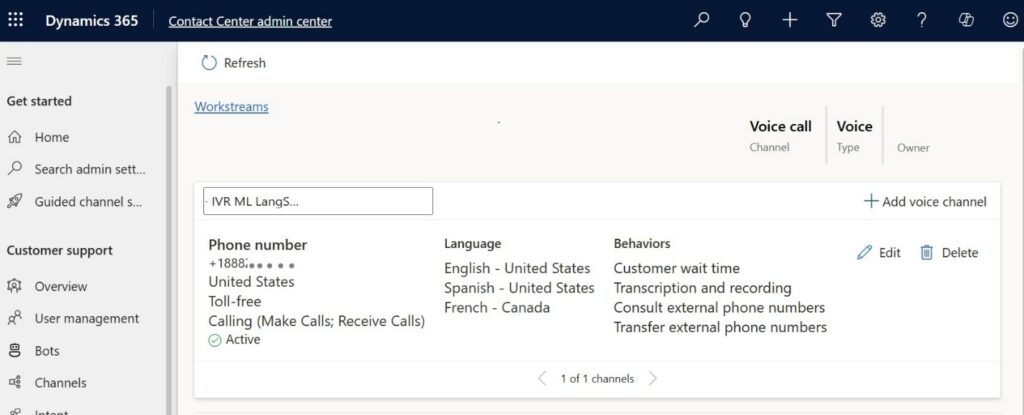
Microsoft is named a Leader in the 2024 Gartner® Magic Quadrant™ for CRM Customer Engagement Center
This article is contributed. See the original author and article here.
Delivering amazing customer experiences and rapid issue resolution across multiple engagement channels is immensely challenging. Without advanced AI and automation—across voice and digital channels—customer journeys meet friction and service reps struggle to work efficiently, leading to spiraling costs and dwindling customer loyalty.
However, when customers and service reps are supported with AI-powered automation and contextual guidance, the experience is smoother for everyone, whether it’s in self-service or assisted service.

2024 Gartner Magic Quadrant for CRM Customer Engagement Center
Microsoft has been recognized as a Leader.
As we enter this new era of AI-fueled customer service, we’re proud to announce that Microsoft has been named a Leader in the 2024 Gartner Magic Quadrant* for CRM Customer Engagement Center.
We believe this placement recognizes our comprehensive AI-powered omnichannel capabilities, our continued commitment to rapid AI innovation, and the successes our global customers are achieving with Microsoft Dynamics 365 Customer Service.

Gartner defines CRM customer engagement center (CRM CEC) as a cohesive set of software built around core case management tools used to provide customer service and support by engaging with customers, while intelligently orchestrating the processes, data, systems, and resources of an organization. CRM CEC applications also offer workflow management capabilities and may be used as a system of record for customer interactions.
AI fuels customer service excellence
Customer service leaders understand that resolving customer issues is not the sole measure of success. Long-term customer loyalty depends on the ability to deliver fast, personalized experiences in every engagement channel. That’s why it’s so important that Customer Service provides comprehensive, AI-enhanced capabilities across omnichannel customer journeys and throughout service processes—on a global scale.
By delivering intelligent self-service and giving service reps the tools and insights to boost productivity, fuel collaboration, and strengthen customer relationships, we help service organizations transform operations and increase customer satisfaction. What’s more, with Microsoft Copilot in Customer Service, organizations can now take their service capabilities to new heights.
Since Microsoft introduced Copilot into the applications millions of people use every day, its generative AI capabilities have empowered people to achieve more—and that’s especially true in customer service.
Copilot is one of the capabilities that sets Customer Service apart. It provides an AI assistant to help service reps onboard faster, accelerate resolutions for even the most complex cases, and free up time to build stronger customer relationships.
Service reps worldwide now rely on Copilot to handle routine tasks—such as accessing knowledge, summarizing, and drafting personalized emails—releasing them to focus on delivering high-value engagements that build customer satisfaction and loyalty.
Lenovo increases service rep productivity by 15% and reduces average handle time by 20%
One organization that is seeing the benefits of Copilot in its customer service operations is the global technology company Lenovo. The company’s Premier Support services give customers access to thousands of advanced technicians to resolve issues and minimize downtime.
To keep pace with growing demand, Lenovo needed automated, AI-based solutions that could streamline operations, automate repetitive tasks, and boost customer satisfaction. The company uses Customer Service and Microsoft Dynamics 365 Contact Center to enhance the support experience for customers and service reps.
When a customer reaches out for support, they interact with Copilot in an AI chat assistant to explain their issue in natural language. Copilot then offers service reps suggestions for optimal solutions, based on millions of historical customer interactions, so reps spend less time finding information and can focus on resolving the issue. Copilot also completes post-call summarization, saving reps even more time.
The results are a 15% improvement in service rep productivity, a 20% reduction in average handling time, and record-high customer satisfaction.
“Our Premier Support service reps are seeing a boost to their productivity and seamless service delivery…average handling time has fallen by 20% and agent productivity is up 15%.”
Chen Lu, Director, Services IT Delivery, Lenovo
Apollo helps customers have smoother journeys
It’s a similar story at Apollo, a major tour operator in the Nordic region, which is using Copilot to help enhance the customer experience for more than one million travelers a year.
The company has built a chatbot in Microsoft Copilot Studio that it expects to respond to up to half of its customer inquiries, providing tailored answers in seconds in Swedish, Finnish, Norwegian, Danish, and Dutch. When cases need to be escalated to a human service rep, Copilot can assist by surfacing relevant information at the right time and completing routine administrative tasks such as call summarization.
“It is always our goal to provide our customers with the journey of a lifetime. Thanks to [Microsoft] Dynamics 365, we can offer each customer personalized experiences with the details that matter most—and we can do it quickly, which is a win for our customers and our business.”
Glenn Bisgaard, Sales Director, Apollo
Copilot and Agents: The next evolution of AI-fueled customer service
Building on the capabilities of Copilot, we’re now introducing AI agents in Copilot, as well as empowering organizations and individuals to create their own agents in Copilot Studio. These agents help transform operations by executing business processes, working alongside or on behalf of a person, team, or organization.
Copilot agents range from simple information retrieval and summarization agents to fully autonomous agents capable of working independently, planning, and orchestrating other agents.
Over the next few months, we’ll be releasing several autonomous agents specifically for enhancing customer service:
- The Customer Intent Agent continuously discovers new intents from customer conversations and keeps self-service tools and service reps updated with new customer issues and how to resolve them.
- The Customer Knowledge Management Agent uncovers insights from human-assisted case notes, transcripts, summaries, and more to update existing knowledge articles or draft new ones, keeping self-service tools evergreen and empowering service reps with up-to-date knowledge and guidance.
- The Case Management Agent reduces reps’ administrative burden and shortens handle times by automating key tasks, including case creation, updates, wrap-up, summary, follow-up communications, and closure.
We’re thrilled to be recognized as a Leader in the Gartner Magic Quadrant, and we’re equally excited about what the future holds as we continue to advance the capabilities of Customer Service. But most importantly, we look forward to seeing the results as we work alongside our pioneering customers to help them deliver even more efficient and effective customer service.
Next steps
Read the 2024 Gartner Magic Quadrant for CRM Customer Engagement Center report.
Learn more about:
1Gartner, Magic Quadrant for CRM Customer Engagement Center, ,
*Gartner is a registered trademark and service mark and Magic Quadrant is a registered trademark of Gartner, Inc. and/or its affiliates in the U.S. and internationally and are used herein with permission. All rights reserved. Gartner does not endorse any vendor, product or service depicted in its research publications, and does not advise technology users to select only those vendors with the highest ratings or other designation. Gartner research publications consist of the opinions of Gartner’s research organization and should not be construed as statements of fact. Gartner disclaims all warranties, expressed or implied, with respect to this research, including any warranties of merchantability or fitness for a particular purpose.
**This graphic was published by Gartner, Inc. as part of a larger research document and should be evaluated in the context of the entire document. The Gartner document is available upon request from Microsoft.
The post Microsoft is named a Leader in the 2024 Gartner® Magic Quadrant™ for CRM Customer Engagement Center appeared first on Microsoft Dynamics 365 Blog.
Brought to you by Dr. Ware, Microsoft Office 365 Silver Partner, Charleston SC.






Recent Comments